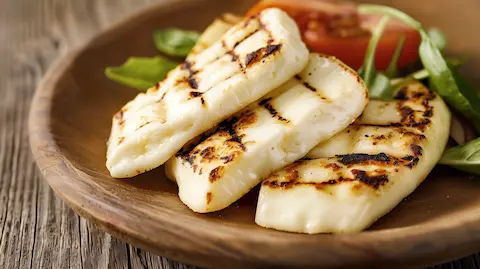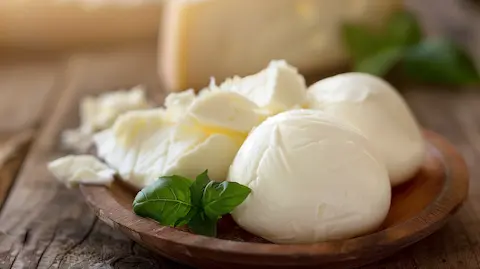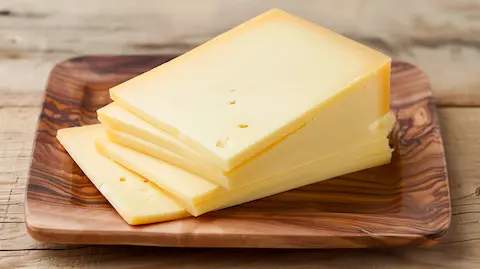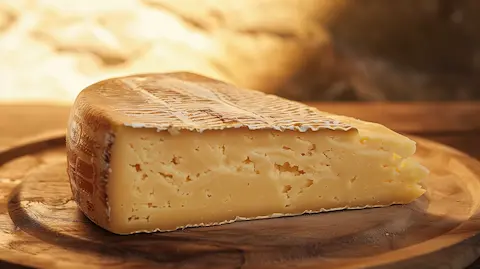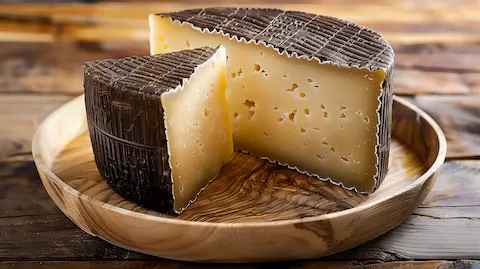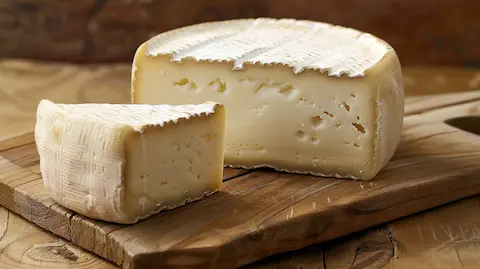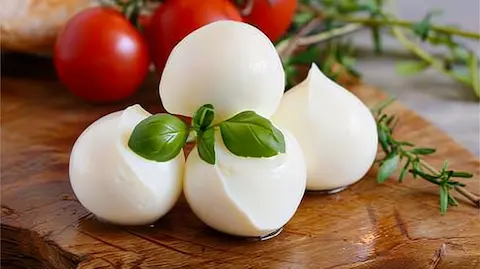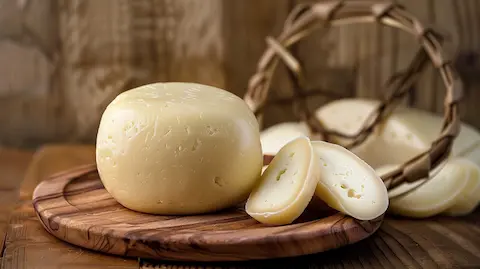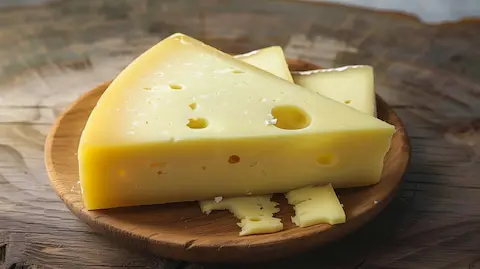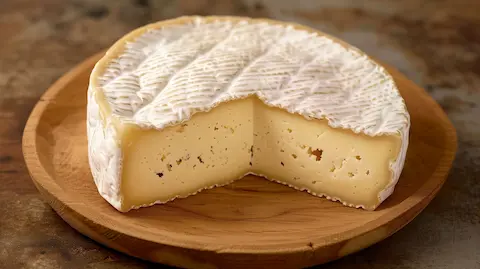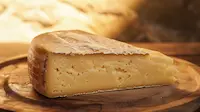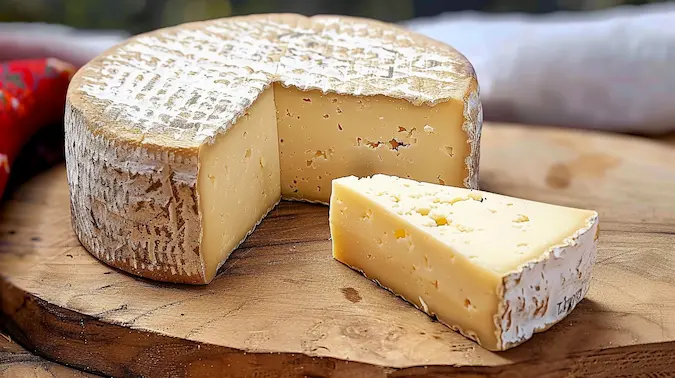Tomme Cheese: A Rustic Delight
Tomme cheese, a term that encapsulates a variety of cheeses from the mountainous regions of France and Switzerland, is a pastoral treasure. These cheeses, often named after their place of origin, are crafted from the milk of cows, goats, or sheep that graze on the rich, diverse flora of alpine pastures. With a history rooted in frugality, Tomme was traditionally made from skimmed milk after the cream was removed to make butter. The resulting cheese is a semi-hard variety, with a thick rind that encases a pate ranging from firm to supple, depending on age.
Each Tomme tells a story of its locale, with subtle variations in flavor and texture that reflect the specific milk used and the unique cheese-making practices of that region. From tomme de savoie with its earthy notes to the fruitier Tomme de Montagne, these cheeses are a testament to the art of cheese-making in the rugged terrain of the Alps.
Unveiling the Craftsmanship Behind Tomme Cheese
tomme cheese is made through a traditional process that starts with the collection of milk from local cows, goats, or sheep. This milk is gently heated and then combined with cultures and rennet, which causes the milk to coagulate into curds. The curds are cut, stirred, and slowly cooked, allowing whey to be released. After draining the whey, the curds are pressed into molds and aged for varying periods, during which the rind develops and flavors mature.
Tomme Cheese Production Process
| Step | Description | Ingredients | Temperature | Duration |
|---|---|---|---|---|
| 1. Heating | Milk is gently warmed to prepare for coagulation. | Cow's, goat's, or sheep's milk | 32°C (90°F) | 15-20 minutes |
| 2. Coagulation | Cultures and rennet are added to milk to form curds. | Cultures, Rennet | 32-34°C (90-93°F) | 30-60 minutes |
| 3. Curd Processing | Curds are cut and stirred to separate from the whey. | 38-40°C (100-104°F) | 20-30 minutes | |
| 4. Molding | Curds are transferred to molds to shape the cheese. | Room temperature | 2-5 hours | |
| 5. Pressing | Cheese is pressed to expel remaining whey and form the rind. | Room temperature | 12-24 hours | |
| 6. Aging | Cheese is aged in controlled conditions to develop flavor. | 10-15°C (50-59°F) | 2-12 months |
What does Tomme taste like?
Tomme tastes like a harmonious blend of nutty and earthy flavors with a hint of grassiness, reflective of the alpine pastures. Its texture can range from semi-firm to supple, with a rind that adds a rustic complexity. The aging process deepens the flavor profile, introducing a slight tanginess and savory notes that can vary from one Tomme variety to another.
The Distinctive Characteristics of Tomme Cheese
Exploring the nuances of Tomme cheese will enhance your appreciation for its unique qualities. Below is a profile that encapsulates the defining aspects of this alpine cheese:
- Made from: Cow's, goat's, or sheep's milk
- Country of origin: France and Switzerland
- Region: Various mountainous regions, including Savoie and the Swiss Alps
- Family: Semi-hard
- Type: Pressed
- Texture: Ranges from semi-firm to supple
- Rind: Thick, often with a gray or brown hue
- Colour: Varies from pale yellow to ivory
- Flavour: Nutty, earthy, with potential fruity undertones
- Aroma: Reflective of alpine pastures, can be mild to pungent
- Vegetarian: Not typically, due to traditional animal rennet use
- Producers: Small-scale farmsteads to larger artisanal operations
- PDO status: Some varieties, like Tomme de Savoie, have Protected Designation of Origin status
Tomme cheese originates from the mountainous regions of France and Switzerland, where the practice of cheese-making has been honed over centuries. These areas provide the ideal conditions for the milk-producing livestock, and the cheese reflects the rich biodiversity of the alpine meadows. Local cheesemongers continue to produce Tomme using time-honored techniques, ensuring each wheel of cheese is a reflection of its terroir.
Mastering the Art of Tomme Preservation
Proper storage of Tomme cheese is key to maintaining its flavor and texture. In a cool, humid environment, Tomme should be wrapped in cheese paper, which allows the cheese to breathe while maintaining optimal humidity. If cheese paper is unavailable, parchment paper can be used as a substitute, followed by loosely wrapping in plastic wrap to prevent the cheese from drying out. Store Tomme in the vegetable compartment of the refrigerator, which typically provides the right conditions.
- Wrapping: Wrap Tomme in cheese paper or parchment paper.
- Covering: Loosely cover the wrapped cheese with plastic wrap.
- Placement: Place the cheese in the vegetable compartment of the refrigerator.
- Humidity: Ensure the storage area is cool and humid to mimic a cheese cave environment.
- Monitoring: Check the cheese regularly for any signs of spoilage or mold.
How long does Tomme cheese last?
The shelf life of Tomme cheese varies depending on storage conditions and whether it is whole or cut. A whole wheel of Tomme, when stored properly, can last for several months in the refrigerator. Once cut, it is best consumed within a few weeks. Freezing Tomme is not recommended, as it can significantly alter the texture, making it crumbly, and can dull the flavors once thawed.
| Storage Location | Whole Tomme | Cut Tomme | Texture After Thawing | Taste After Thawing |
|---|---|---|---|---|
| Outside | 2-4 hours | 1-2 hours | ||
| Fridge | 2-4 months | 2-4 weeks | ||
| Freezer | Not recommended | Not recommended | Crumbly | Dulled flavors |
Is Tomme cheese pasteurized?
Tomme cheese can be made from both pasteurized and unpasteurized milk, depending on the producer's methods and local regulations. Pasteurized Tomme is more common in markets that require pasteurization for safety reasons, while unpasteurized (raw milk) Tomme may be found in regions with less restrictive dairy laws or at specialty cheese shops that focus on traditional cheese-making practices.
Is Freezing Tomme Cheese a Viable Option?
No, freezing Tomme cheese is not recommended. While it is technically possible to freeze it, the process can greatly affect its texture and flavor. Freezing can cause the cheese to become crumbly and may dull the nuanced tastes that characterize Tomme, diminishing the overall experience of enjoying this artisanal cheese.
Alternatives to Tomme Cheese
If you're seeking to explore cheeses with a profile similar to Tomme, or if Tomme is simply unavailable, there are several excellent alternatives that can provide a comparable taste experience. The following table outlines some of the best substitutes for Tomme cheese, detailing their origins, characteristics, and why they make a fitting replacement.
Tomme Cheese Substitutes
| Cheese | Origin | Milk Source | Texture | Flavor | Aging Time | Best Used In |
|---|---|---|---|---|---|---|
| Gruyère | Switzerland | Cow | Firm | Nutty, slightly sweet | 6-12 months | Fondue, gratin, sandwiches |
| Fontina | Italy | Cow | Semi-soft | Rich, earthy | 3 months | Risotto, pizza, pasta |
| Comté | France | Cow | Firm | Complex, fruity, nutty | 4-24 months | Charcuterie boards, gratins |
| Reblochon | France | Cow | Semi-soft | Creamy, nutty | 1-2 months | Tartiflette, cheese boards |
| Asiago | Italy | Cow | Firm to hard | Sweet, tangy | 4-12 months | Grated on dishes, sandwiches |
| Raclette | Switzerland/France | Cow | Semi-soft | Mild, slightly sweet | 3-6 months | Melting, raclette grills |
Tomme Popular Comparison
Gruyère is a cheese that often finds itself compared to Tomme due to their shared Alpine heritage and similar flavor profiles. Both cheeses are excellent for melting and offer a nutty, earthy taste that is beloved in culinary applications.
Creative Culinary Adventures with Tomme
Tomme's versatile nature allows for a variety of culinary uses. To cut Tomme for serving, a sharp knife should be used to slice it into thin wedges or small cubes, depending on your preference and the dish's requirements. This cheese can be savored on its own, melted into a comforting dish, or added to a cheese board for a touch of rustic charm. Its ability to complement a range of flavors makes it a fantastic ingredient for cooking, enhancing everything from salads to gratins.
| Use | Description |
|---|---|
| On its own | Savor the cheese in its pure form to appreciate its full flavor. |
| Melting | Add to hot dishes like soups and casseroles for a creamy texture. |
| Cheese boards | Pair with fruits, nuts, and bread for a well-rounded cheese platter. |
| Salads | Cut into cubes and toss with greens for a hearty salad. |
| Sandwiches | Layer slices in sandwiches for a nutty, earthy flavor. |
| Gratins | Grate and sprinkle over dishes before baking for a golden crust. |
How to serve Tomme cheese
Serving Tomme cheese at room temperature brings out its full range of flavors and textures. Present it sliced on a cheese board, accompanied by a selection of bread, fruit preserves, and charcuterie. For an enhanced tasting experience, pair Tomme with a light-bodied red wine, such as a Pinot Noir, or a crisp white wine, like a Chardonnay, to balance its rich and nutty profile.
Recipes Using Tomme
Tomme's rich and varied flavor profile makes it a standout ingredient in diverse recipes. Its ability to complement a broad spectrum of ingredients, from the delicate to the robust, allows it to enhance dishes without overpowering them. Whether melted into a dish or served as a key element on a cheese board, Tomme's versatility is a testament to its culinary adaptability.
- Tomme Tartiflette: This traditional Savoyard dish is a perfect match for Tomme, with its creamy texture melting into the potatoes and bacon.
- Roasted Vegetable and Tomme Galette: The semi-hard cheese adds a savory depth to the sweetness of roasted veggies.
- Tomme and Thyme Stuffed Chicken: The subtle flavors of Tomme pair well with poultry, creating a moist and flavorful filling.
- Alpine Macaroni: Incorporating Tomme into this hearty pasta dish brings a touch of the Alps to your table.
- Tomme Cheese Fondue: A smooth, velvety fondue that showcases Tomme's excellent melting properties and nutty taste.
Understanding the Nutritional Profile of Tomme
There are 300 calories in Tomme cheese per 100g. Tomme provides a good source of protein and calcium, which are vital for muscle and bone health. However, it is also high in fat, particularly saturated fat, and sodium. These factors should be considered within the context of a balanced diet, especially for individuals monitoring their intake of these nutrients.
| Nutrient | Amount per 100g | % Daily Value* |
|---|---|---|
| Calories | 300 | - |
| Total Fat | 24g | 37% |
| Saturated Fat | 16g | 80% |
| Cholesterol | 90mg | 30% |
| Sodium | 620mg | 26% |
| Total Carbohydrates | 1g | <1% |
| Dietary Fiber | 0g | 0% |
| Sugars | 0.5g | - |
| Protein | 20g | 40% |
| Calcium | 500mg | 50% |
*Percent Daily Values are based on a 2,000 calorie diet. Your daily values may be higher or lower depending on your calorie needs.
What's next? WhatCheese insights
If you are a connoisseur seeking Tomme cheese, artisanal cheese shops and specialty food stores are your best bet for finding an authentic selection. These establishments often source directly from producers in the Alps, ensuring that you receive a product that's rich in heritage and flavor. Additionally, online cheese retailers have become a reliable resource, offering a variety of Tomme cheeses with detailed descriptions of their origin and tasting notes, making it easier for enthusiasts to purchase this rustic delight from anywhere in the world.
If you are interested in pairing Tomme with the perfect wine, I recommend exploring vineyards that offer cheese tastings alongside their wine selections. Such vineyards are often found in regions with a strong cheese-making tradition, such as the Rhône-Alpes area in France or the Swiss canton of Valais. These tastings not only enhance the enjoyment of both the cheese and wine but also provide valuable insights into the art of pairing from knowledgeable sommeliers and cheesemongers. Keep an eye out for local cheese festivals and food fairs as well, where Tomme can often be found and enjoyed in a lively, educational setting.
For those who appreciate the semi-hard texture and nuanced flavors of Tomme, I suggest exploring other cheeses like Beaufort, Abondance, and Ossau-Iraty. These varieties share similar characteristics and are excellent for those looking to expand their palate within the semi-hard cheese category.

